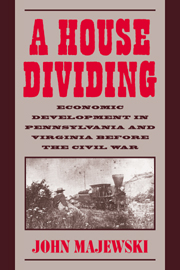Book contents
- Frontmatter
- Contents
- List of Tables
- List of Abbreviations
- Acknowledgments
- Maps
- Introduction: Regional Development in Comparative Perspective
- 1 Developmental Corporations in a Slave-Labor Society
- 2 Developmental Corporations in a Free-Labor Society
- 3 Railroads and Local Development
- 4 The Local Politics of Market Development
- 5 Urban Capital and the Superiority of Pennsylvania's Transportation Network
- 6 Why Antebellum Virginians Never Developed a Big City: Comparative Urban Development in Philadelphia and Eastern Virginia
- Epilogue: Railroad Networks and the Civil War
- Appendix on Sources and Methods
- Bibliography
- Index
Appendix on Sources and Methods
Published online by Cambridge University Press: 07 September 2010
- Frontmatter
- Contents
- List of Tables
- List of Abbreviations
- Acknowledgments
- Maps
- Introduction: Regional Development in Comparative Perspective
- 1 Developmental Corporations in a Slave-Labor Society
- 2 Developmental Corporations in a Free-Labor Society
- 3 Railroads and Local Development
- 4 The Local Politics of Market Development
- 5 Urban Capital and the Superiority of Pennsylvania's Transportation Network
- 6 Why Antebellum Virginians Never Developed a Big City: Comparative Urban Development in Philadelphia and Eastern Virginia
- Epilogue: Railroad Networks and the Civil War
- Appendix on Sources and Methods
- Bibliography
- Index
Summary
Most statistical appendixes serve as a refuge for tables and topics too dull for the main text. The reason for their lackluster state is not hard to surmise. Historians eagerly devote page after page to the latest theoretical concepts, but often gloss over the nuts and bolts of archival research and statistical methods. This appendix tries to be a bit different. Although arranged topically, it narrates the many mistakes and occasional discoveries that I made in the seven years of researching and writing this book. Much of what follows will strike many as pedestrian and commonsensical. But however simple-minded this discussion may be, it at least highlights a question that often receives little attention: How do historians produce new knowledge? The emphasis on the mundane and the practical, I hope, will not only save fellow researchers the many hours that I wasted following dead-end leads and wrong-headed techniques, but also help demystify social science history.
Let us begin with the very basics: computer programs. After spending hundreds of hours entering in names and numbers, I began to see the computer as an essential tool for accomplishing my task. The program that I used most often for entering data and performing computations was Microsoft Excel. I stumbled onto Excel by accident, but the program has proven effective for my needs, especially as it improved over the years. As a spreadsheet, Excel allows one to sort a large number of records alphabetically, a particularly useful function when linking names from census records and tax lists to business records.
- Type
- Chapter
- Information
- A House DividingEconomic Development in Pennsylvania and Virginia Before the Civil War, pp. 173 - 183Publisher: Cambridge University PressPrint publication year: 2000

